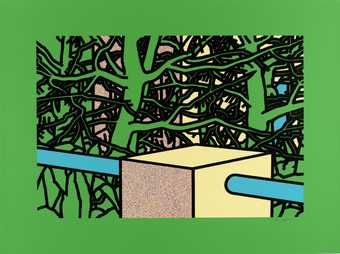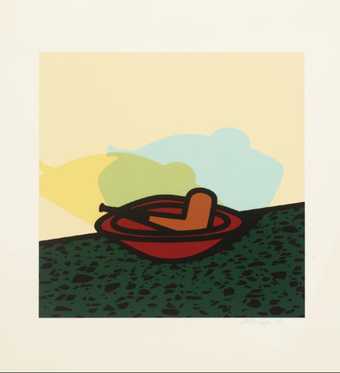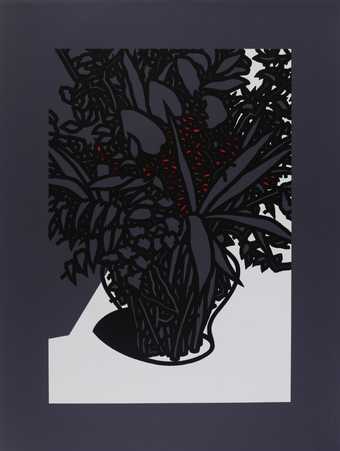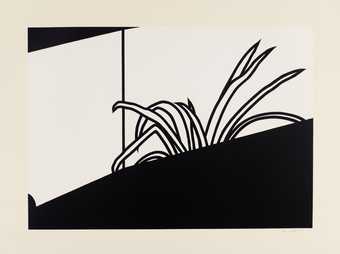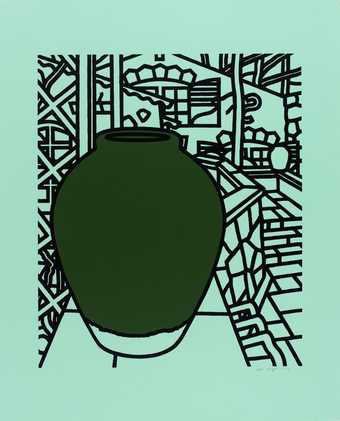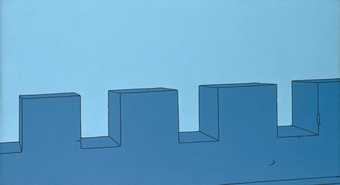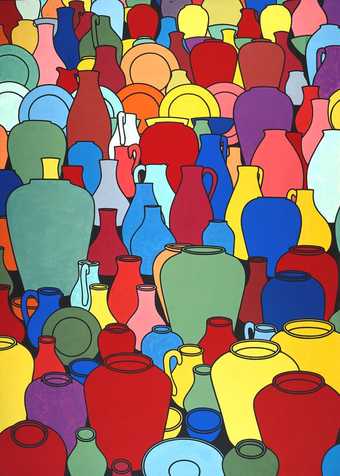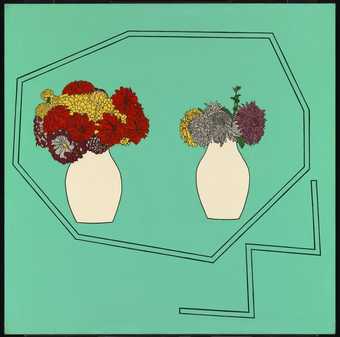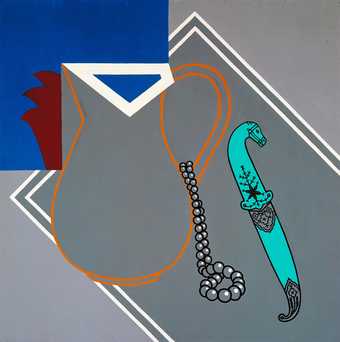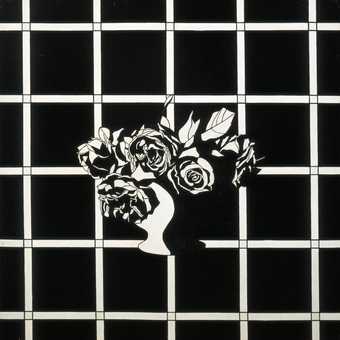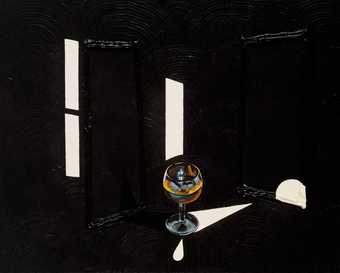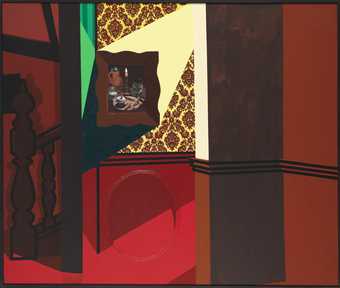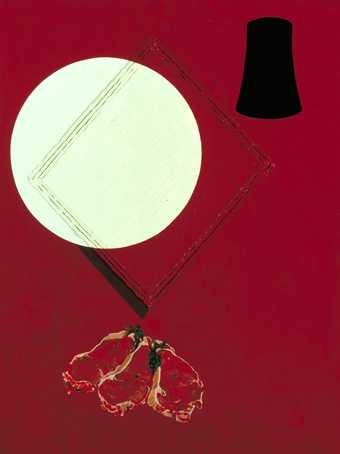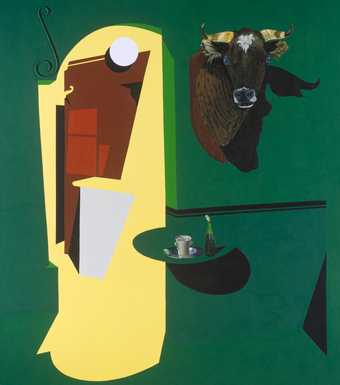
In Tate Liverpool
- Artist
- Patrick Caulfield 1936–2005
- Medium
- Acrylic paint on canvas
- Dimensions
- Support: 2489 × 2134 mm
- Collection
- Tate
- Acquisition
- Purchased 1976
- Reference
- T02033
Display caption
Patrick Caulfield’s paintings explore alternative ways of picturing the world. After Lunch was one of his earliest works to combine different styles of representation. In this case, what appears to be a photomural of the Château de Chillon hanging in a restaurant is depicted with high-focus realism, contrasting with the cartoon-like black-outlined imagery and fields of saturated colour of its surroundings. Caulfield deliberately makes the relationship between these varying representational methods uneasy and ambiguous, so that the picture appears more real than the everyday world around it.
Gallery label, November 2016
Does this text contain inaccurate information or language that you feel we should improve or change? We would like to hear from you.
Catalogue entry
T02033 AFTER LUNCH 1975
Inscribed on canvas turnover, upper right, ‘AFTER LUNCH PATRICK CAULFIELD 1975’
Acrylic on canvas, 98×84 (249×213.5)
Purchased from the Waddington Galleries with funds provided by the Tate Gallery Publications Department, the Trustees of the Tate Gallery Trust fund and the Grant-in-Aid 1976
Exh: Waddington Galleries stand, Basle Art Fair, Swiss Industries Fair Hall, Basle, June 1975; Patrick Caulfield Recent Paintings, Waddington Galleries II, November–December 1975 (repr. in colour in unnumbered catalogue)
Restaurant interiors are a subject Caulfield has treated often. Within the general interest his work shows in social customs and taste, the recurrence of the restaurant theme is connected with his longstanding preoccupation with formalizing the elements in nature (in its widest sense). Not only can this more extensively be done with city than with country subject matter, but restaurants afford far more possibilities for compositional devices and particular detail than do domestic interiors. As in all Caulfield's paintings, the particular scene represented in ‘After Lunch’ is-though familiar-imaginary. It typifies his tendency to paint subjects which are slightly ‘ugly’. However, in order to build up the picture into a convincing atmosphere and scene, and at the same time in order to make the subject come alive for him, he needs to introduce as many individual represented elements as possible consistent with his formal requirements for the picture. These little elements combine to create a ‘texture’ and an image towards which, as the work progresses, Caulfield's feelings become ones of affection. ‘After Lunch’ and works like it are thus in no sense cynical in content.
In ‘After Lunch’ as in many of his recent works, he made the element which is depicted as ‘closest’ to the viewer the same size as it would be if the viewer was part of the scene in real life. This increases the picture's illusionistic aspect, which other details contradict. The type of chair seen in ‘After Lunch’ might be uncomfortable in a restaurant, but Caulfield chose it because it could be seen through and thus would not dominate the foreground. A further motive, to which this contributed, was the wish to create as complicated a space as possible. For some time, Caulfield has been interested in formalizing light. The moment shown in this painting is one when the lights have been turned off at the end of lunch in the restaurant (one reason for the pervasive blue of the picture). A parallel beam of light traverses the scene with a clarity deriving from the smoke-laden after lunch atmosphere. The head of the waiter (his professional identity established by so minimal a means as a bow tie, one of the only two small areas of the painting made of solid, filled-in black) was painted from drawings by Caulfield of a friend who is not a waiter in real life. The restaurant is assumed from the ways in which it emphasises Swissness (fondu pot, wooden interior, subject of photo-mural) not to be in Switzerland. The boat-like structure above the waiter's head is derived from an object in the form of an ox-or milkmaid-yoke holding (as here) two candles, seen in a photograph of a domestic interior. Caulfield's decision to include a tank of goldfish derived not only from the aptness of this detail in the setting but also from awareness of the precedent for this motif in Matisse, and from interest both in introducing a further kind of transparency and in the notion, here, of painting water on top of water and fish on top of (presumed) fish.
‘Paradise Bar’ 1974 (repr. Art in America, LXIV, January–February 1975, p.86) was the first painting into which Caulfield introduced a passage so as to contrast incongruously with his own style as seen in the rest of the picture. In that instance, the introduced passage was a loose interpretation of a landscape mural, itself in a loose, semi-abstract idiom, which Caulfield had seen in an Indian restaurant in Westbourne Grove. After completing ‘Paradise Bar’, Caulfield wished to make another painting containing a passage that should be no less incongruous but of a different type. He discovered in Chiswick a supplier of photo-murals and bought two, being delighted by the supplier's comment that they were out of fashion. For ‘After Lunch’ he chose the photo-mural of the chateau of Chillon on Lake Geneva, his pleasure at its suitability being enhanced by the fact that it had so many associations. These included the fact that Byron had written a poem about it, that Courbet had painted it, and that Mont Blanc was seen in the background. In order to maintain the illusion of perspective in his painting overall, Caulfield cut the photo-mural so that it was not itself rectilinear, and placed it at a height in the canvas such that the horizon in the photo-mural would be on the viewer's eye-line. He first employed this photo-mural in ‘After Lunch’ by sticking it (after cutting) direct onto the canvas. However, this did not work physically. He therefore decided to try to copy it accurately in paint, a technique he had not employed for about twenty years. ‘After Lunch’ was the first of Caulfield's mature paintings to include a photo-realist passage.
Like most of Caulfield's recent paintings, ‘After Lunch’ as a whole was made in the following way. He first imagined the kind of composition and details he wanted, establishing these in one or more drawings leading to a final, not very large drawing which he then squared up. He then covered the bare canvas with polythene which he also squared up, and transferred the image to the polythene. Then after applying a basic ground colour to the canvas, he traced the image onto it from the polythene, and finally painted in any passages that required a colour not already provided by the ground.
Published in:
The Tate Gallery 1974-6: Illustrated Catalogue of Acquisitions, London 1978
Explore
- abstraction(8,615)
-
- non-representational(6,161)
-
- colour(2,481)
- places of entertainment(399)
-
- restaurant(74)
- agriculture, gardening & fishing(951)
-
- yoke(5)
- mural(36)
- candle(71)
- fondue pot(1)
- fish tank(3)
- countries and continents(17,390)
-
- Switzerland(1,058)
- Alps(836)
- Lake Geneva(87)
- Mont Blanc(59)
- trading and commercial(1,154)
You might like
-
Patrick Caulfield Garden with Pines
1975 -
Patrick Caulfield Pipe in Bowl
1976 -
Patrick Caulfield [no title]
1976 -
Patrick Caulfield Spider Plant
1973 -
Patrick Caulfield Jar
1974 -
Patrick Caulfield Battlements
1967 -
Patrick Caulfield Pottery
1969 -
Patrick Caulfield Vases of Flowers
1962 -
Patrick Caulfield Still Life with Dagger
1963 -
Patrick Caulfield Greece Expiring on the Ruins of Missolonghi (after Delacroix)
1963 -
Patrick Caulfield Black and White Flower Piece
1963 -
Patrick Caulfield Second Glass of Whisky
1992 -
Patrick Caulfield Interior with a Picture
1985–6 -
Patrick Caulfield Grill
1988 -
Patrick Caulfield Hemingway Never Ate Here
1999

